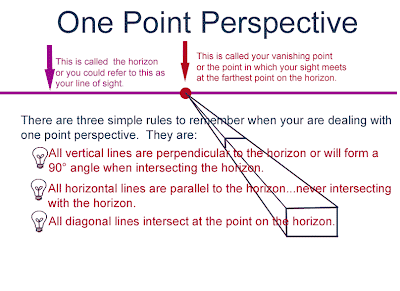Two point perspective has two vanishing points on the horizon, usually one left and one right. Think of looking at the corner of a building from a distance, you'd see one wall disappearing off to one side, and one to the other side. Again, scale is created by placing lines radiating out from both points.
Three-Point Perspective ("birds eye view") has three vanishing points. Keep in mind that when using three point perspective things get a little weird. When working with this concept, objects become very distorted since you do not have the real space to emulate the real world. Therefore, objects seem squished and distorted. This is often used in animation, especially with action comics to create drama, action and sense of space in an imagined world.
A couple youtube videos you might find helpful:
One-Point Perspective: www.youtube.com/watch?v=adRWYWSw2XI
Two-Point Perspective: www.youtube.com/watch?v=KE3ZkWtX8UU



No comments:
Post a Comment